Related Research Articles
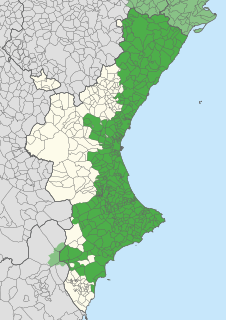
Valencian is the official, historical and traditional name used in the Valencian Community (Spain) to refer to the Romance language also known as Catalan. The Valencian Community's 1982 Statute of Autonomy and the Spanish Constitution recognise Valencian as the official language in the Valencian Community.

Catalan Countries refers to those territories where the Catalan language, or a variant of it, is spoken. They include the Spanish regions of Catalonia, Valencia, the Balearic Islands and parts of Aragon and Murcia, as well as the department of Pyrénées-Orientales in France, the Principality of Andorra, and the city of Alghero in Sardinia (Italy). In the context of Catalan nationalism, the term is sometimes used in a more restricted way to refer to just Catalonia, Valencia and the Balearic Islands. The Catalan Countries do not correspond to any present or past political or administrative unit, though most of the area belonged to the Crown of Aragon in the Middle Ages. Parts of Valencia (Spanish) and Catalonia (Occitan) are not Catalan-speaking.
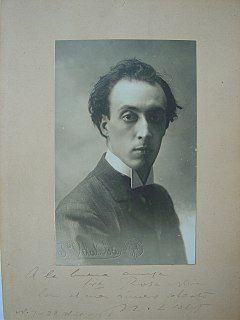
Miguel Llobet Solés was a classical guitarist, born in Barcelona, Spain. Llobet was a renowned virtuoso who toured Europe and America extensively. He made well known arrangements of Catalan folk songs for the solo guitar, made famous arrangements for the guitar of the piano compositions of Isaac Albéniz, arrangements immortalized by Andrés Segovia, and was also the composer of original works.

Juan del Encina was a composer, poet, and playwright, often called the founder, along with Gil Vicente, of Spanish drama. His birth name was Juan de Fermoselle. He spelled his name Enzina, but this is not a significant difference; it is two spellings of the same sound, in a time when "correct spelling" as we know it barely existed.
Juan Bautista Comes, aka per Valencian spelling Joan Baptista Comes, was a Spanish Baroque composer who was born and died in Valencia.
Ginés Pérez de la Parra, also known as Juan Ginés Pérez, was a Spanish composer during the Renaissance. He was born in Orihuela, a city in what is now the province of Alicante. His work and that of his contemporaries led to the formation of a stylistic school of music known as "valenciana."
Atrium Musicae was an early music ensemble from Madrid, Spain, founded in 1964 by Gregorio Paniagua, a Spanish monk.
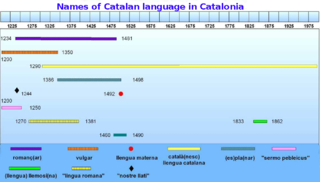
The first names, or glossonyms, of the Catalan/Valencian language formed in a dialectal relation with Latin, in which Catalan existed as a variety. These names already expressed the relationship between the two languages. New names that related Catalan to Rome came about to dignify the Catalan language in the thirteenth century, though Latinists called it vulgar and the people planus, or pla.

Valencian nationalism or Valencianism is a political movement in the Land of Valencia, Spain.
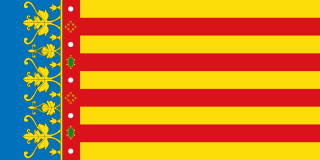
The Himne de l'Exposició or Himne de València is the official anthem of the Valencian Community, Spain. The song was composed by José Serrano Simeón with lyrics written by Maximiliano Thous Orts for the 1909 Valencian Regional Exhibition. The music is based on a 16th-century anthem dedicated to Saint George, who was the patron saint of the Kingdom of Valencia. It was approved by the mayors of Alicante, Castellón and Valencia in May 1925, and it was declared as the official anthem of the Valencian Community in 1981, with the approval of the Valencian Statute of Autonomy.
Eduardo Paniagua is a Spanish architect and musician, specializing in medieval Spanish music.
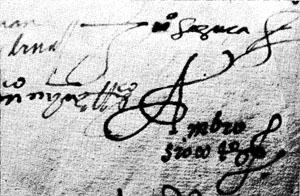
Ambrosio Cotes was a Spanish Renaissance composer.
Capella de Ministrers is an early music group formed in 1987 in Valencia, Spain by Carles Magraner. Valencian music is prominent in its repertoire.
La mà de Guido is a Catalan music publishing house in Barcelona, Spain founded in 1986 by the composer and musicologist Llorenç Balsach.

Ars Musicae de Barcelona was a Catalan ensemble for the performance of medieval music active between 1935 and 1979.

Mara Aranda is a Spanish singer.
The Cancionero de Segovia or Cancionero Musical de Segovia (CMS), also known as Cancionero of the Segovia Cathedral, is a manuscript containing Renaissance music from the end of the 15th century and beginning of the 16th century. It contains a wide repertoire of works by mainly Spanish, French and Franco-Flemish composers. It is kept at the Segovia Cathedral Archives.
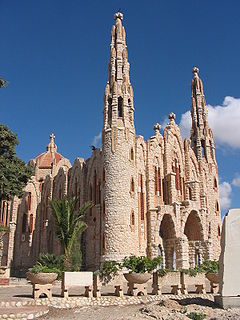
Valencian Art Nouveau, is the historiographic denomination given to an art and literature movement associated with the Art Nouveau in the Valencian Community, in Spain.
José Luis Lopátegui Rodríguez was a Spanish musician, classical guitarist and professor.
References
- ↑ "Goldberg article".
- ↑ "JOSÉ R". www.uv.es.
- ↑ José Ramón Gil Tárrega O quam suavis: para coro mixto 1988
- ↑ Eduardo López-Chavarri Andújar Compositores valencianos del siglo XX: del modernismo a las vanguardias 1992 p271
- ↑ Eduardo López-Chavarri Andújar Breviario de historia de la música valenciana 1985
- ↑ "Victoria Musicae | principal". www.victoriamusicae.com.
- ↑ Serra d'or cultural magazine, Abbey of Montserrat 2001 p621
- ↑ Estudis romànics. Institut d'Estudis Catalans 2003 p443 "i en aquesta nova estrena a Santa Maria del Mar, pel grup Victoria Musicae que dirigeix Josep R. Gil Tàrrega, arran de la imposició, no d'una corona"
- ↑ Bibliographic Guide to Music 2002